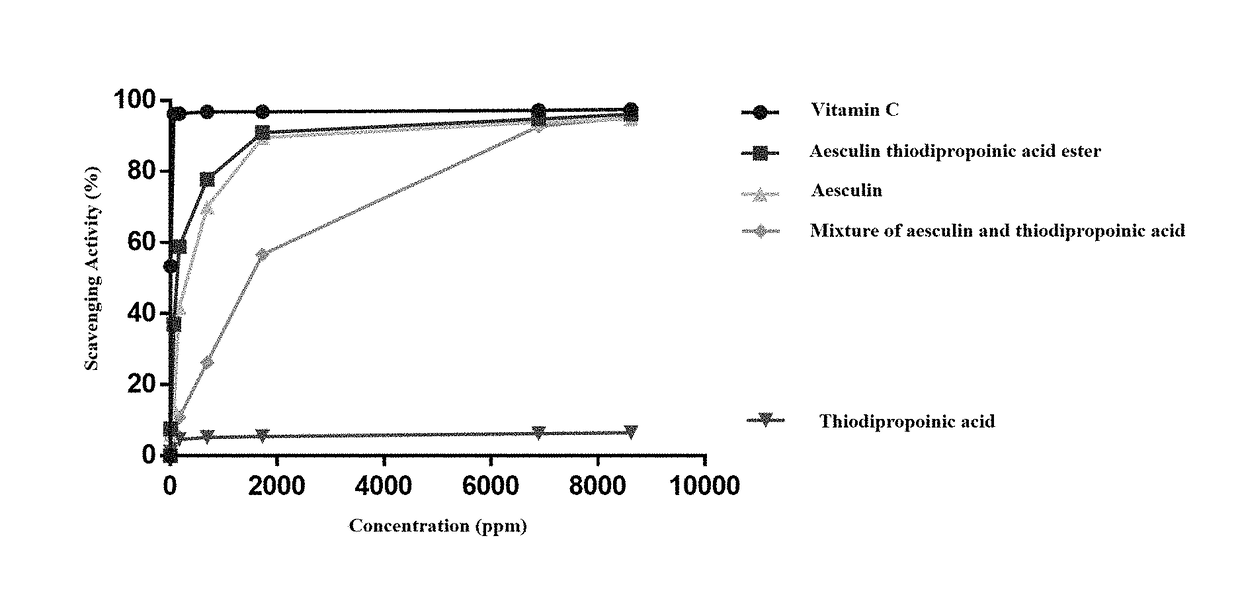Aesculin thiodipropionic acid ester with antioxidant activity and a method of preparing the same
a technology of aesculin thiodipropionic acid and antioxidant activity, which is applied in the field of food and cosmetic additives, can solve the problems of food spoilage, food is spoiled and degraded by microorganisms, and the deterioration of oils or fats,
- Summary
- Abstract
- Description
- Claims
- Application Information
AI Technical Summary
Benefits of technology
Problems solved by technology
Method used
Image
Examples
example 1
Preparation of the Aesculin Thiodipropionic Acid Ester (Formula I)
[0026]100 mg (0.29 mmol) aesculin and 23.8 mg (0.134 mmol) 3,3′-thiodipropionic acid were placed in a 100 mL reactor. 50 mL acetonitrile was added to form a reaction mixture. 61.9 mg (0.3 mmol) DCC and 2.6 mg DMAP were then added to the reaction mixture. The reaction mixture was heated at 40° C. under sonication and nitrogen atmosphere for 4 hours. The reaction mixture was cooled down to room temperature, concentrated under reduced pressure, filtered, and dried with sodium sulfate. Solvent in the reaction mixture was then removed to obtain 107.6 mg the aesculin thiodipropionic acid ester, a yield of 89.03%.
[0027]1H-NMR (400 MHz, DMSO-d6) δ (ppm): 7.67 (2H, d), 6.73 (2H, s), 6.53 (2H, s), 6.15 (2H, d), 5.86 (2H, d), 5.21 (2H, s), 4.36-4.10 (6H, m), 3.81 (2H, t), 3.52 (6H, s), 3.40-3.53 (4H, m), 2.80 (4H, t), 2.59 (4H, t); 13C-NMR (400 MHz, DMSO-d6) δ (ppm): 171.6, 160.6, 148.7, 145.6, 143.0, 113.6, 111.0, 109.4, 102.7,...
example 2
Preparation of the Aesculin Thiodipropionic Acid Ester
[0028]100 mg (0.29 mmol) aesculin and 26.2 mg (0.147 mmol) 3,3′-thiodipropionic acid were placed in a 100 mL reactor. 50 mL acetonitrile was added to form a reaction mixture. 61.9 mg (0.3 mmol) DCC and 2.6 mg DMAP were then added to the reaction mixture. The reaction mixture was heated at 35° C. under sonication and nitrogen atmosphere for 5 hours. The reaction mixture was cooled down to room temperature, concentrated under reduced pressure, filtered, and dried with sodium sulfate. Solvent in the reaction mixture was then removed to obtain 96.8 mg the aesculin thiodipropionic acid ester, a yield of 80.12%.
example 3
Preparation of the Aesculin Thiodipropionic Acid Ester
[0029]100 mg (0.29 mmol) aesculin and 23.8 mg (0.134 mmol) 3,3′-thiodipropionic acid were placed in a 100 mL reactor. 50 mL acetone was added to form a reaction mixture. 61.9 mg (0.3 mmol) DCC and 2.2 mg triethylamine were then added to the reaction mixture. The reaction mixture was heated at 40° C. under sonication and nitrogen atmosphere for 4 hours. The reaction mixture was cooled down to room temperature, concentrated under reduced pressure, filtered, and dried with sodium sulfate. Solvent in the reaction mixture was then removed to obtain 90.1 mg the aesculin thiodipropionic acid ester, a yield of 82.01%.
PUM
| Property | Measurement | Unit |
|---|---|---|
| Temperature | aaaaa | aaaaa |
| Temperature | aaaaa | aaaaa |
| Time | aaaaa | aaaaa |
Abstract
Description
Claims
Application Information
 Login to View More
Login to View More - R&D
- Intellectual Property
- Life Sciences
- Materials
- Tech Scout
- Unparalleled Data Quality
- Higher Quality Content
- 60% Fewer Hallucinations
Browse by: Latest US Patents, China's latest patents, Technical Efficacy Thesaurus, Application Domain, Technology Topic, Popular Technical Reports.
© 2025 PatSnap. All rights reserved.Legal|Privacy policy|Modern Slavery Act Transparency Statement|Sitemap|About US| Contact US: help@patsnap.com



